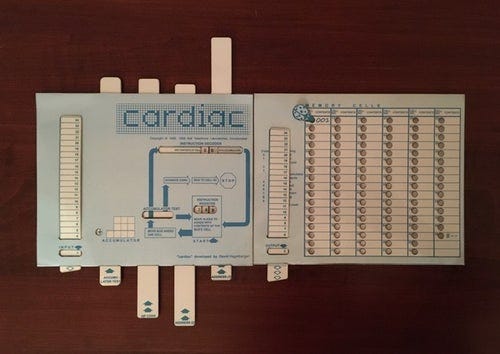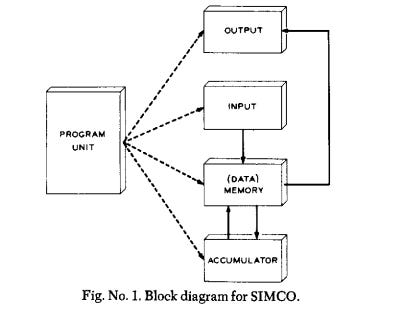Weekly Geekly Rundown for June 9, 2023
Cardboard Computers, Board Games, Movies, and More.
The CARDiac is a Cool Way to Learn How Computers Work
I moved around a lot as a kid, but I’ve always felt lucky with regards to the educators and organization leaders I had access to as a kid. Though I went to one of the poorer high schools in Reno, NV, a school not typically known for being a high performing school, the school had some excellent teachers and some surprising program offerings. These included an annual trip to the Ashland Oregon Shakespeare Festival with Mr. Janke, a very good Math teacher in Marco Bisio, and a 0 period computer programming course. It was in that course that I learned to program in BASIC, a skill set that faded for a while but provided a good foundation when I started learning Python and R.
Of course, when I was a kid BASIC was everywhere, which had been John Kemeny’s plan in the first place. He wanted to create a computer language that was accessible to everyone, so that everyone could do basic (pun intended) computer processes to aid them in their regular pursuits. BASIC itself is dead. That is unless you are an Excel power user, a retrocomputing advocate, or count the fact that Kemeny’s dream of wide scale adoption of computing skills throughout the population. Then BASIC is very much alive.
Heck, I’m even working with my 15 year old daughters to build an 8-bit SmartyKit this summer and we plan on seeing if we can expand the memory and install BASIC on it to run some simple programs. My daughters are learning Python in school, but our home projects will include replicating exercises on the Raspberry Pi on our Commodore 64. We’ll be using a Commodore 64 user port breakout board to simulate the GPIO on the Pi.
One of the things I really like about BASIC, and one of the reasons that it really cannot become the wide spread language of applications today, is that you can use BASIC to directly access memory locations (poking and peeking) in a very transparent way. Modern high-level languages are slightly less transparent in this way and I think it is important to visualize how you are actually interacting with the computer so that you can understand how it processes information and what it means when we say it’s all 0s and 1s.
As I said earlier, I feel lucky to have had the opportunity to learn BASIC as a kid, but when I saw what kids in the 60s had access to I became a little jealous. In the early days of the computer revolution, Bell Labs (inventor of the transistor and SO MUCH MORE) created the CARDiac Cardboard Computer as an illustrative aid to help kids understand how computers worked. It’s a really remarkable piece of work that shows physically the processes that I am trying to convey by having my daughters do some BASIC programming. The user manual for the CARDiac even includes an illustration of the basic architecture of van Neumann machines.
Thankfully, there are some very good sites that provide not only the background and historical information about the CARDiac, but files you can use to build your own and an online CARDiac simulator (you can find Brent Wilkins’ code here). I’m totally doing this with my daughters too. If you want to know more about the CARDiac and similar instructional tools, I recommend Mark Jones Lorenzo’s book The Paper Computer Unfolded.
Two Quick Board Game Announcements
Crossbows and Catapults Hurtling Towards Us in a New Edition
Restoration Games is planning a new edition of the classic kids game Crossbows and Catapults. They are making an official restoration of the iconic 1983 Crossbows & Catapults game, but if it’s anything like their restorations of Fireball Island, Dark Tower, or Thunder Road then there will be a lot of new flare to the restoration.
Heroscape is Back from the Dead Again!!!
In even bigger news, for me at least, Renegade Games has licensed the rights to publish the new version of Heroscape. Last year, Hasbro ran a crowdfunding campaign for Heroscape on their HasLab platform, but that failed to secure enough backers (though it did secure a good sum of money in pledges) to launch. I was disappointed and hoped that we would see the results of that hard work someday. Looks like Renegade games has come to the rescue.
Weekly Luke Y Thompson and Courtney Howard Review Cavalcade
Courtney Howard provides a very positive review for the bittersweet love story Past Lives over at Fresh Fiction. As a fan of Il Mare and The Lake House, yes I liked both but preferred the dog in the first one, I think I might have preferred a more positive ending than is suggested in the review, but the film sounds very interesting and I will certainly take the time to watch it.
Luke Y Thompson review of Flamin’ Hot for ComingSoon provides a nice intersection for two of his roles as a reviewer, snacks and movies. For a time, when Luke was the editor at The Robot’s Voice (and after too I think), he did a fairly regular column reviewing various snack innovations. I thought it was an interesting review beat and on that fit well in a city that had a food review scene that included Jonathan Gold.
Luke is a horror film expert who has not merely reviewed them for top sights, but has even starred in them. He’s one of the rare critics (and yes they are far too rare) who understands not just the film theory learned in Journalism or Film School course, but knows the ins and outs of how they are made. He brings that point of view and experience into his review of Hollywood Dreams & Nightmares: The Robert Englund Story.
While I won’t watch the film, I trust Luke when he says that DC’s new Flash film delivers on multiple levels and it looks like Courtney Howard really liked it too. I wish it was a film I could watch in good conscience, but for now it goes on the mental shelf with Chinatown.
Luke’s review of Transformers: Rise of the Beasts comes from a long time fan of the IP. Luke’s not too impressed with the latest film and thinks it could use a little more Bay. Personally, I have a love/hate relationship with the Transformers films and it’s “all Michael Bay’s fault.” There were a number of directions Bay could have gone when he launched the franchise in the early 2000s. He could have gone full nostalgia and innocence making something light hearted that featured humans and Autobots banding together to battle the Decepticons in a world without real risk to the human participants. He might have gone completely the other route and portrayed a timeline that showed what it would really be like to involve humans in that kind of conflict, combining horrors of real war with a science fiction narrative.
There are other options to be sure, but both of these fit pretty well into Bay’s wheelhouse. Instead, in the Bayest of Bay directoral choices, he chose to do both and it never quite meshed. We got the silliness of Bumblebee stumbling around the house to hide from parents and we got moments that approached the Navy Seal scene in The Rock, but that pulled away from the full emotional impact knowing that kids would be watching the picture. I don’t envy Bay the challenge he gave himself. “Dark and Serious but watchable by 7 year-olds” is a challenge. I admire him for trying, but ultimately think he failed. He didn’t fail to create some amazing moments, even in The Last Knight I found myself cheering when Mark Wahlberg uses Excalibur…only to have it be completely forgotten forever after. I think that legacy provides a similar challenge for future directors and my sense is that most will fail to navigate that balance.
Speaking of toys and Thompson, he’s got a review of the new Transformers toys over at SuperHeroHype.
Classic Movie Recommendation
There has been a meme going around recently asking people to share a movie they always recommend to people. For me, that’s an easy one. Peter Yates’ 1979 film Breaking Away is a wonderful tale that speaks of the importance of friendship and captures almost perfectly the effects of a shift from an industrial to an information economy has on the hopes and dreams of the working class. It also speaks to the importance of friendship and the responsibility we have to our friends and to ourselves.









Cool stuff. I think the movies I always tend to recommend is either 500 days of summer, or Office Space.